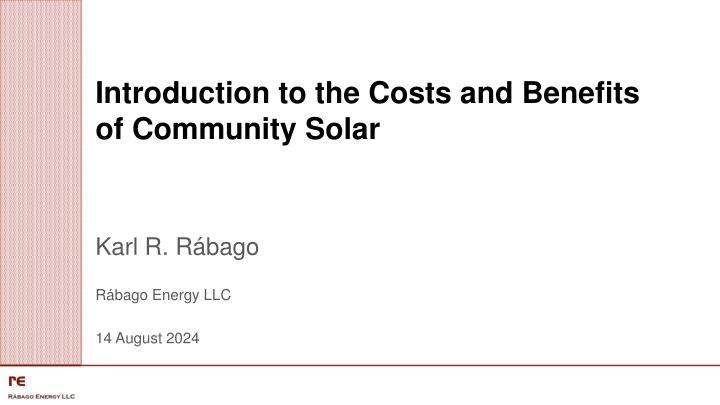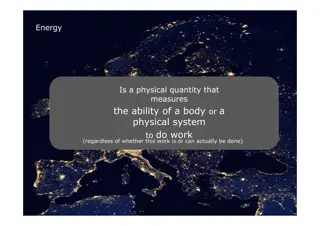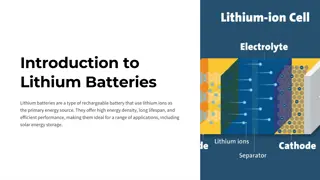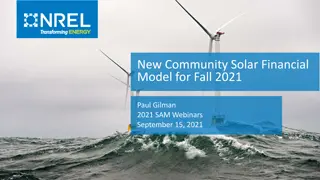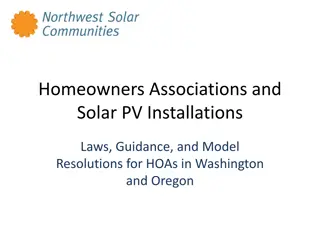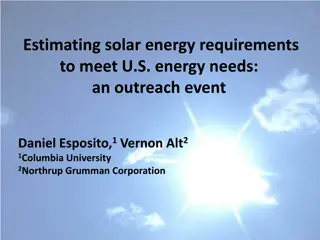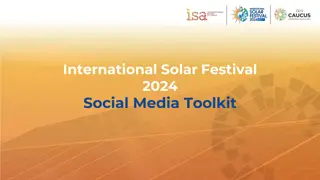Introduction to the Costs and Benefits of Community Solar
This presentation by Kent Chandler, Chairman of the Kentucky Public Service Commission, discusses securitization and its impact on utility customer costs amidst energy price volatility. The PSC's mission, regulatory functions, and historical context of utility regulation in Kentucky are highlighted. The focus is on ensuring safe, reliable service at reasonable prices while maintaining financial stability.
Download Presentation

Please find below an Image/Link to download the presentation.
The content on the website is provided AS IS for your information and personal use only. It may not be sold, licensed, or shared on other websites without obtaining consent from the author.If you encounter any issues during the download, it is possible that the publisher has removed the file from their server.
You are allowed to download the files provided on this website for personal or commercial use, subject to the condition that they are used lawfully. All files are the property of their respective owners.
The content on the website is provided AS IS for your information and personal use only. It may not be sold, licensed, or shared on other websites without obtaining consent from the author.
E N D
Presentation Transcript
Introduction to the Costs and Benefits of Community Solar Karl R. R bago R bago Energy LLC 14 August 2024
Rbago Energy LLC 34 years utility regulation & markets, plus bioplastics and biofuels. Testimony in 170+ utility cases & proceedings. Attorney. Former Armored Cavalry Officer, JAG, TX PUC Commissioner, DOE Deputy Asst Secretary, utility executive, wind & solar developer, environmental advocate, sustainability manager, carbon credit developer, law professor, R&D manager, consultant, etc. Easily bored. 2 Economical Community Solar 14 August 2024
Accounting for Distributed Solar Costs & Benefits Research & numerous cost-benefit analyses show that investing in large AND small-scale energy resources offers a myriad of benefits to the entire electric grid that benefits all ratepayers. That s because smaller projects produce energy near where it is needed and make more efficient use of existing infrastructure (including utility-scale resources), allowing utilities to avoid certain costs that ratepayers would otherwise incur. This saves ratepayers $$billions in the long run. (VCE Local Solar Roadmap, 2021). Quantifiable benefits include, among others: (1) private capital investment in the distribution grid, (2) avoided transmission costs, (3) greater fuel diversity & reduced volatility, (4) peak load reduction, (5) capital investment deferral, and (6) line losses. There are also larger societal benefits like local economic development, increased competition, innovation, speed, and addressing high household and business energy burdens. Even under conservative analysis, distributed solar pays for itself in savings. In God we Trust All Others Must Bring Data and Benefit-Cost Analysis Economical Community Solar 14 August 2024
Economical Community Solar 14 August 2024
Cost Shifts Electric service is founded on the principle that you pay for what you use, not for what you don t use. There is huge variety in when and how much energy we use. Why should customers who use less utility energy be required to pay for costs they don t create? Community solar customers can reduce their energy bills and their use of utility-generated energy, just like customers that invest in energy efficiency. If the utility didn t plan for that solar, they will make less money from the customer. Utilities rates are based on the utility forecast of sales. SO: It s a rates problem ONLY IF the utility didn t plan for it. Even if community solar grew many times larger, the potential short-term bill impacts are small compared to those from volatile gas prices, utility grid spending, and other causes. Most importantly, the net benefits to all customers and the grid from community solar deployment are massive and significantly outweigh the costs. Done right, community solar lowers rates for all customers. Economical Community Solar 14 August 2024
Consider: Tomatoes Big box grocery tomatoes are cheap Home-grown tomatoes are more nutritious, home growers share extra tomatoes with neighbors, home growers have tomatoes all summer and save on trips to the grocery Home-grown tomatoes reduce big-box tomato sales Big-box grocery wants you to pass a law limiting home growing of tomatoes AND for home growers to pay a fee to maintain profits lost from reduced big box store sales Or Big box grocery starts selling better tomatoes, ordering fewer tomatoes, stocking different vegetables, etc. Economical Community Solar 14 August 2024
Additional Resources Local Solar for All Roadmap: https://www.localsolarforall.org/roadmap National Standard Practice Manual for Benefit-Cost Analyses of Distributed Energy Resources: https://www.nationalenergyscreeningproject.org/national-standard-practice-manual/ Review of Recent Cost-Benefit Studies Related to Net Metering and Distributed Solar: https://www.energy.gov/sites/prod/files/2020/06/f75/ICF%20NEM%20Meta%20Analysis_Formatted%20FINAL_ Revised%208-27-18.pdf NREL Quantifying DPV Costs and Benefits: https://www.nrel.gov/docs/fy19osti/72165.pdf NREL Grid Connected Distributed Generation Compensation Mechanisms: https://www.nrel.gov/docs/fy18osti/68469.pdf Daymark Costs and Benefits study from Maryland: http://www.solarwakeup.com/wp-content/uploads/2018/11/MDVoSReportFinal11-2-2018.pdf IREC s Regulator s Guidebook: Calculating the Benefits and Costs of Distributed Solar Generation: https://irecusa.org/resources/a-regulators-guidebook-calculating-the-benefits-and-costs-of-distributed-solar- generation/ Economical Community Solar 14 August 2024
Thank you! Karl R. R bago R bago Energy LLC karl@rabagoenergy.com 512.968.7543 @rabagoenergy 8 Economical Community Solar 14 August 2024
